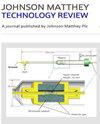利用胺供体n -苯基腐胺(NPP)和Johnson Matthey转氨酶生物催化剂库合成胺
IF 2
4区 化学
Q4 CHEMISTRY, PHYSICAL
引用次数: 0
摘要
手性胺是制药、农化和化学工业的重要组成部分。有一种动力是用生物催化剂等绿色替代品来增加传统的过渡金属催化剂。转氨酶(TA)生物催化剂可以与“智能”牺牲胺供体结合使用,从相应的醛和酮合成各种脂肪胺和芳香胺。尽管ta具有巨大的潜力,但不利的反应平衡往往限制了ta在工业合成中的广泛应用。最近,我们披露了一种新的仿生胺供体n -苯基腐胺(NPP),它的灵感来自于二吡咯喹啉生物碱的生物合成。NPP对商业和野生型菌株(共25个)具有良好的活性。这项工作的重点是探索NPP与Johnson Matthey TA试剂盒(17种生物催化剂;8个s选择性和9个r选择性)和三种不同的胺受体(香兰素,苯甲醛和苯乙酮)。NPP对所有17种TAs均有良好的反应,并以高达85%的高效液相色谱收率得到相应的香兰胺、苄胺和甲基苄胺。从筛选中,STA-14被确定为一种良好的生物催化剂,可用于进一步分析,并用于NPP与常用供体iPrNH2的比较筛选。结果表明,NPP是最佳的胺供体,并以>99.5%的e - e制备了s -甲基苄胺。本工作结合我们前期的研究,突出了NPP在生物催化合成胺方面的潜力。本文章由计算机程序翻译,如有差异,请以英文原文为准。
Amine Synthesis Using the Amine Donor N-Phenyl Putrescine (NPP) and the Johnson Matthey Transaminase Biocatalyst Library
Chiral amines are important building blocks in the pharmaceutical, agrochemical and chemical industries. There is a drive to augment traditional transition metal catalysts with green alternatives such as biocatalysts. Transaminase (TA) biocatalysts can be used in combination with "smart" sacrificial amine donors to synthesise a variety of aliphatic and aromatic amines from the corresponding aldehydes and ketones. Despite their enormous potential, the unfavourable reaction equilibrium often limits the widespread application of TAs for industrial synthesis. Recently we disclosed a new biomimetic amine donor N-phenyl putrescine (NPP), which was inspired by the biosynthesis of the dipyrroloquinoline alkaloids. NPP was demonstrated to have good activity with a library of commercial and wild-type TAs (total 25 TAs). This work focused on exploring the use of NPP with the Johnson Matthey TA kit (17 biocatalysts; 8 S-selective and 9 R-selective) and three different amine acceptors (vanillin, benzaldehyde and acetophenone). NPP worked well with all 17 TAs and gave the corresponding amine products vanillylamine, benzylamine and methylbenzylamine in up to 85% HPLC yield. From the screen, STA-14 was identified as a good biocatalyst for further analysis and used in a comparative screen of NPP versus the commonly used donor iPrNH2. It was found that NPP was the best amine donor and used to prepare S-methylbenzylamine in >99.5% e.e. This work, combined with our previous study, highlights the potential of NPP in the biocatalytic synthesis of amines.
求助全文
通过发布文献求助,成功后即可免费获取论文全文。
去求助
来源期刊

Johnson Matthey Technology Review
CHEMISTRY, PHYSICAL-
CiteScore
4.30
自引率
4.30%
发文量
48
审稿时长
12 weeks
期刊介绍:
Johnson Matthey Technology Review publishes articles, reviews and short reports on science enabling cleaner air, good health and efficient use of natural resources. Areas of application and fundamental science will be considered in the fields of:Advanced materials[...]Catalysis[...][...]Characterisation[...]Electrochemistry[...]Emissions control[...]Fine and speciality chemicals[...]Historical[...]Industrial processes[...]Materials and metallurgy[...]Modelling[...]PGM and specialist metallurgy[...]Pharmaceutical and medical science[...]Surface chemistry and coatings[...]Sustainable technologies.
 求助内容:
求助内容: 应助结果提醒方式:
应助结果提醒方式:


